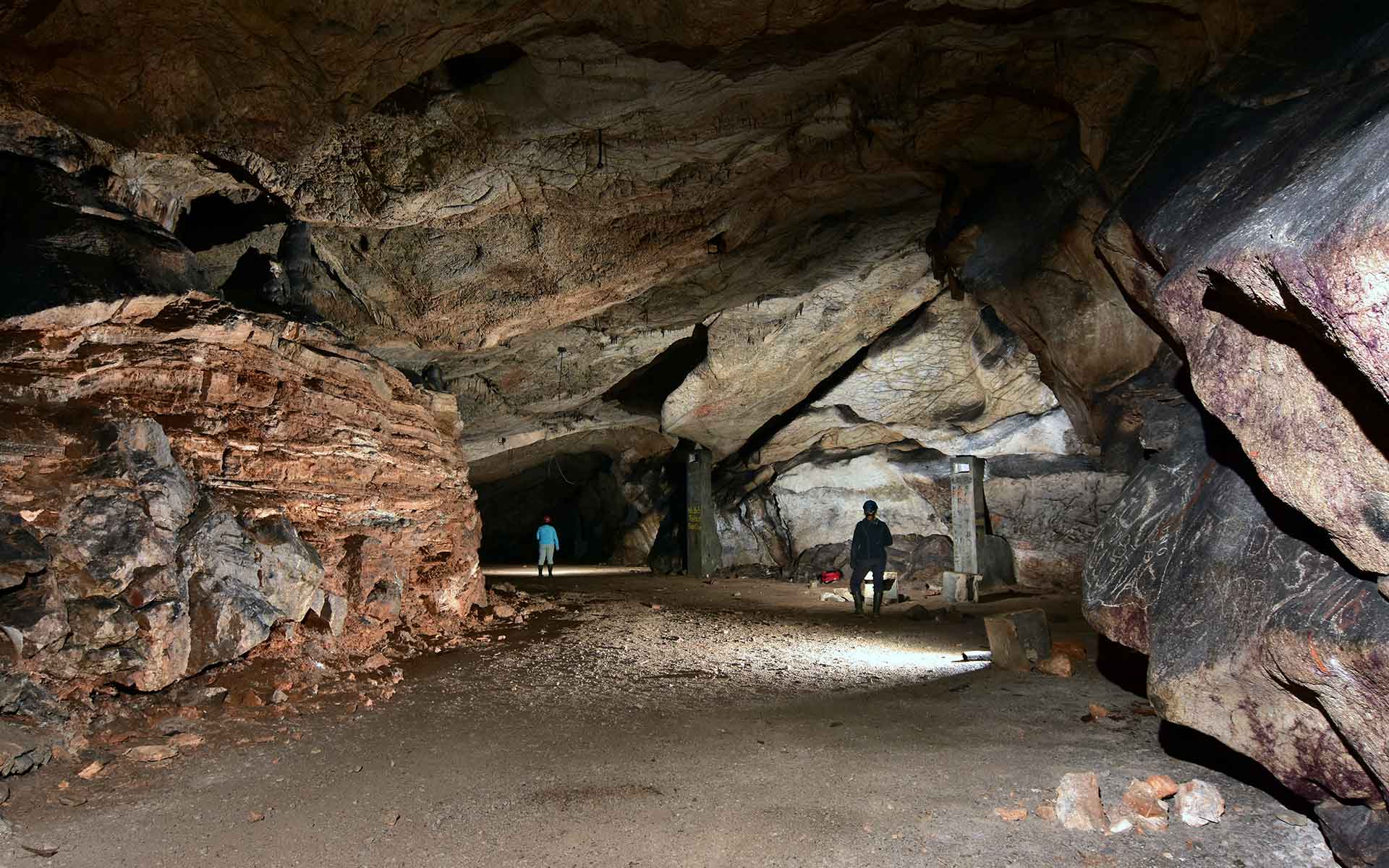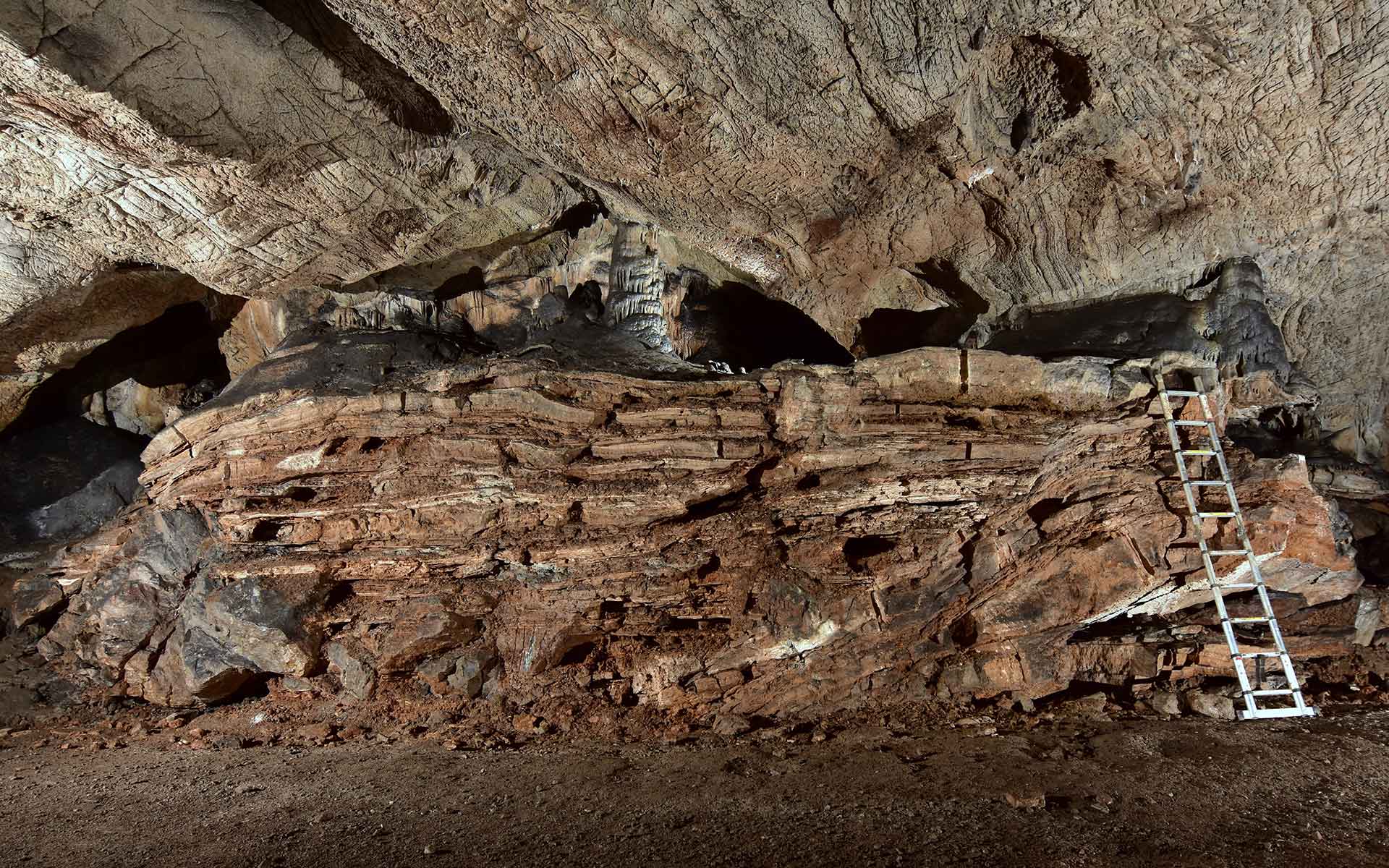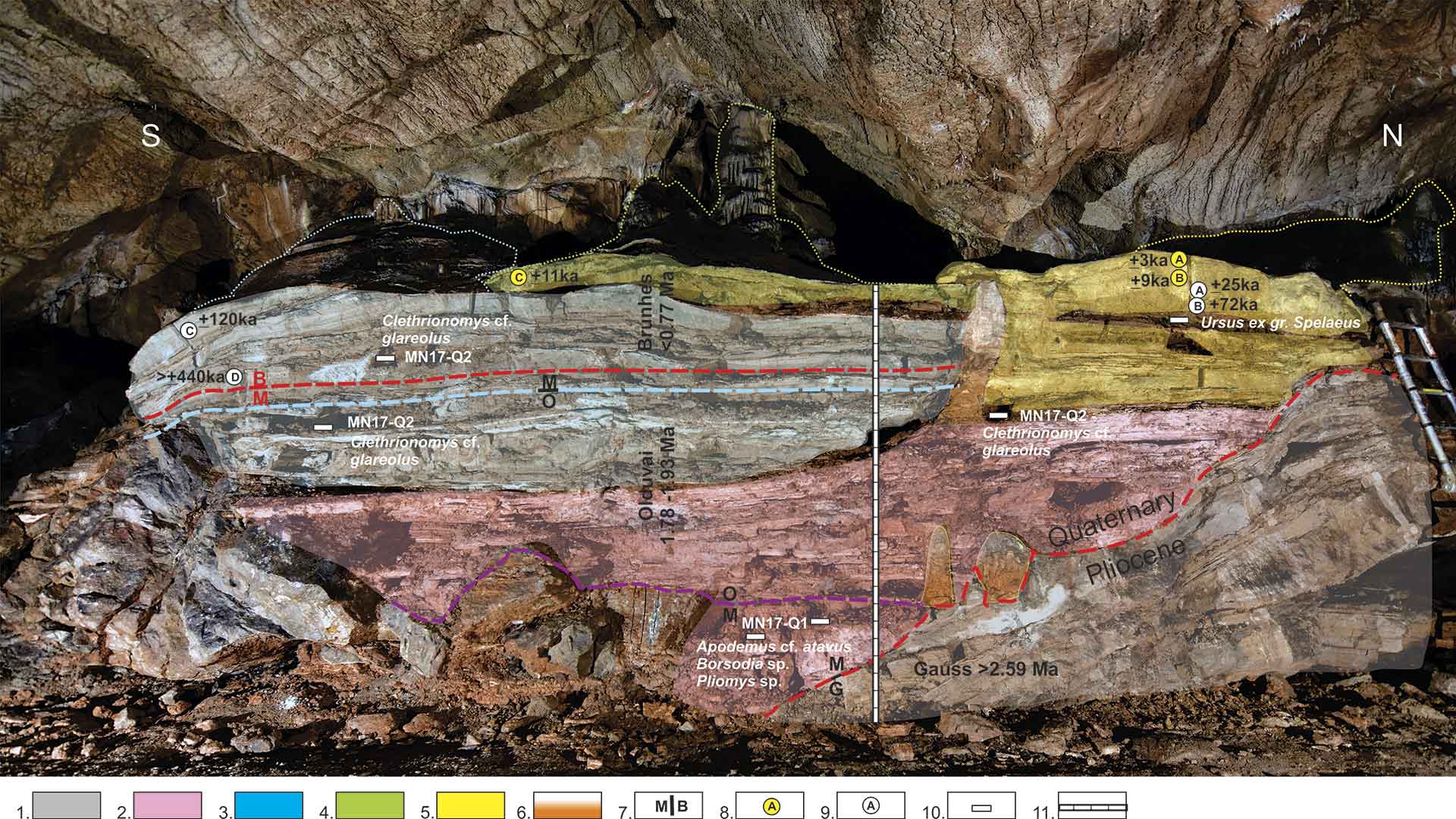
Anthropogenic activity during the 20th century, that is, military use of Raciška Pecina Cave, led to the exposure of calcite layers in the stalagmite dome section. Additionally, the natural cave floor was leveled during this time. (Photo: Jurij Hajna).
Geological Period
Pliocene to Pleistocene
Main geological interest
Stratigraphy and sedimentology
Location
Classical Karst, Slovenia
45°30’12”N, 014°09’00”E
Anthropogenic activity during the 20th century, that is, military use of Raciška Pecina Cave, led to the exposure of calcite layers in the stalagmite dome section. Additionally, the natural cave floor was leveled during this time. (Photo: Jurij Hajna).
A multi-proxy record of landscape and paleoenvironmental changes during the last 3.4 million years, including Pliocene-Pleistocene and Matuyama-Brunhes geomagnetic field reversals.
The Raciška Pecina section contains multiple chronostratigraphic and paleoclimatic proxies that allow global correlations. In particular, the Matuyama/Brunhes boundary is accurately documented within 6 mm interval. Anchored in an age model derived from oxygen isotope stratigraphy, this brief but incisive event is characterized by discernible changes in oxygen and carbon isotope ratios, trace element concentrations and calcite fabric. The remains of the fauna provide valuable insights into past ecosystems and the biodiversity dynamics. The discovery of the first known cave gastropod fossil underlines the paleontological importance of the site. The radiocarbon dating of soot layers, indicating the presence of humans, further enhances the scientific value of the site.
- Geological description
The Raciška Pecina limestone cave situated in the External Dinarides has a sedimentary sequence spanning from the Late Pliocene to the present day. The deposition of speleothem layers, intermittently interrupted by infiltrations of clay and silt from the surface, contributes to a comprehensive chronostratigraphic record. The chronology, based on magnetostratigraphy, isotope-oxygen stratigraphy and various dating methods, including paleontological, U-series and radiocarbon dating (Zupan Hajna et al., 2020, 2021), highlights important milestones such as the Pliocene to Pleistocene transition and the precise identification of the Matuyama/Brunhes transition at 777.7±6 ka (Pawlak et al., 2024). The fluctuations in stable isotopes within the stratigraphic layers, which range from approximately 3.4 Ma to 80 ka, serve as indicators of environmental change (Sierpien et al., 2021). The stratigraphic layers also harbor a diverse fossil fauna that provides invaluable insights into past ecosystems. Representative fauna from the Early and Late Pleistocene (Horácek et al., 2007; Zupan Hajna et al., 2021), including Ursus ex gr. spelaeus (±72 ka) and the first known fossil cave gastropod Zospeum sp. (±2 Ma) populate the stratigraphic layers and offer insights into past ecosystems. In addition, radiocarbon dating of soot material in three layers suggests the presence of humans in the cave.
- Scientific research and tradition
In the early 20th century, the cave served as a military arsenal, and extensive trenches dug into the massive speleothem domes reveal their inner layers. Since 2002, studies of the cave’s sediment layers have enhanced our understanding of chronostratigraphy and climate changes (e.g. Zupan Hajna et al., 2021; Sierpień et al., 2021; Pawlak et al., 2024).
The section provides insight into various aspects including the growth relations of speleothem domes (1-5), stalagmites (6), paleomagnetic boundaries (7), dating results (8 – radiocarbon, 9 – U/Th), paleontology (10), and a stable isotopes log (11). Notably, the M/B boundary is highlighted in red, standing out as particularly significant. Modified from Zupan Hajna et al. (2021).
- Reference
Horáček, I. et al. (2007) ‘Fossil Vertebrates and Paleomagnetism Update of One of the Earlier Stages of Cave Evolution in the Classical Karst, Slovenia: Pliocene of Črnotiče II Site and Račiška Pečina Cave’, Acta Carsologica, 36(3). Available at: https://doi.org/10.3986/ac.v36i3.179.
Pruner, P. et al. (2010) ‘Magnetostratigraphy and fold tests from Račiška pečina and Pečina v Borštu caves (Classical Karst, Slovenia)’, Studia Geophysica et Geodaetica, 54(1), pp. 27–48. Available at: https://doi.org/10.1007/s11200-010-0002-1.
Sierpień, P. et al. (2021) ‘Flowstones from the Račiška Pečina Cave (SW Slovenia) Record 3.2-Ma-Long History’, Geochronometria, 48, pp. 31–45. Available at: https://doi.org/10.2478/geochr-2021-0004.
Zupan Hajna, N. et al. (2020) ‘Karst sediments in Slovenia: Plio-Quaternary multi-proxy records’, Quaternary International, 546, pp. 4–19. Available at: https://doi.org/10.1016/j.quaint.2019.11.010.
Zupan Hajna, N. et al. (2021) ‘Pliocene to Holocene chronostratigraphy and palaeoenvironmental records from cave sediments: Rači\vska pečina section (SW Slovenia)’, Quaternary International, 605–606, pp. 5–24. Available at: https://doi.org/10.1016/j.quaint.2021.02.035.
- Author(s)
Nadja Zupan Hajna.
ZRC SAZU Karst Research Institute. Slovenia.
Astrid Švara.
Karst Research Institute ZRC SAZU. Slovenia.


